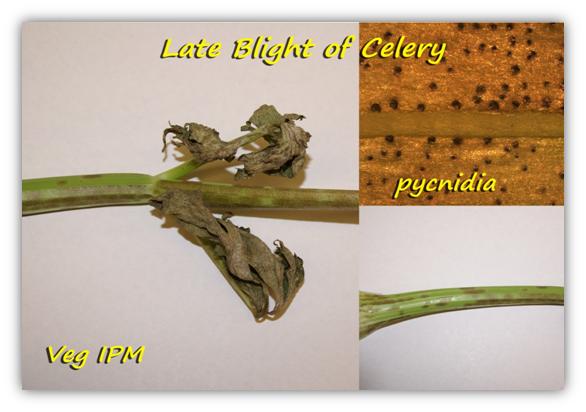 |
|
|
|

|
|||
| |
|||
Late blight of celery, also known as Septoria blight, is one of the major diseases on this crop worldwide. The causal pathogen is the fungus Septoria apiicola. Periods of wet weather that favor disease development can result in significant yield and quality losses when the pathogen is present. The disease can occur in Arizona celery fields; however, the generally dry environment in this region restricts rapid and widespread disease development. Disease symptoms on leaves begin as irregularly shaped spots that are initially yellow, then turn necrotic and coalesce causing leaf blight. Infections also occur on the stalk. Small spore-producing fungal bodies called pycnidia will appear in the necrotic tissue on leaves and stalks. Pycnidia are similar in color and size to ground pepper grains and each pycnidium can produce from 1,500 up to 4,000 spores. The usual sources of initial inoculum in many celery production regions include infested seed and overseasoning celery debris; however, in desert production areas crop debris rapidly decomposes and is not likely a factor in disease initiation. Since seeds are an important source of inoculum, planting pathogen-free seeds is a crucial disease management decision. However, even so-called pathogen-free seed lots may contain a very low level of infested seed, which can in turn lead to occasional infected plants. If fungicide application is necessary, compounds such as azoxystrobin, chlorothalonil, copper hydroxide, propiconazole, pyraclostrobin, and trifloxystrobin can be effective disease management tools.
To contact Mike Matheron go to: matheron@ag.arizona.edu.
|
|||
| Back | |||
For questions or comments on any of the topics please contact Marco Pena at the Yuma Agricultural Center. |
|||
| Home | Cotton
| Veggies | Forages
| Grains | Citrus
| Crop x Crop Insects | Diseases| Weeds | Pesticides | Economics | News | Weather | Research | Photos | Contacts | General Info. Copyright © 2001 University of Arizona, College of Agriculture and Life Sciences Webmaster: Al Fournier (acis@ag.arizona.edu) |
|||
